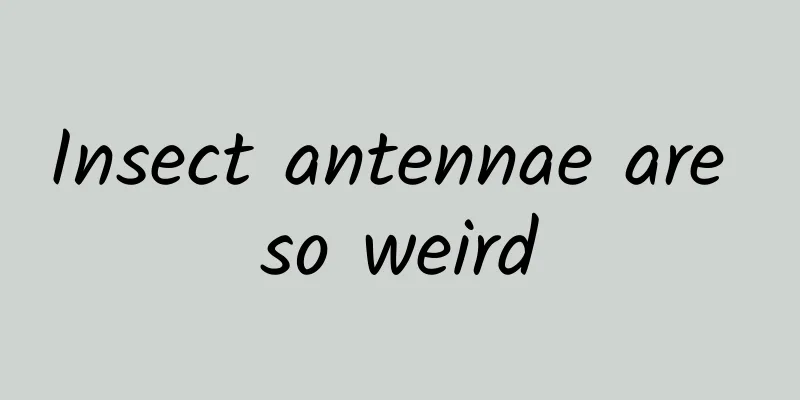Insect antennae are so weird

|
Source: www.countytimes.co.uk Huer Insects are very versatile, just look at their antennae. You will find that these antennae come in all shapes and sizes. + Various types+ According to the shape, length, structure, etc. of the antennae, insect antennae can be divided into 12 basic types. Setae-like antennae, which can be seen on the heads of dragonflies, cicadas, leafhoppers, etc.: Source: quizlet.com Long, linear antennae, also called filamentous antennae, are the most common type of insect antennae. Representative insects include longhorn beetles and katydids. Source: See watermark The males of the Lepidoptera family also often have long, linear antennae. From a distance, do they look like two antennae tied on their heads? Source: BITH*/flickr Nemophora degeerella Rosary-shaped antennae that resemble a string of beads are common antennae of termites, scorpions, etc.: Source: www.billclarkbugsperts.com The rod-shaped antennae of butterflies and antlers are similar in structure to the thread-shaped antennae, but the proximal segments are enlarged like rods: Source: See watermark Hammer-shaped antennae are also swollen at the end, but much shorter, shaped like a small hammer, such as the antennae of the Guogong insect: Source: bugguide.net Some beetles and male scorpions often have serrated antennae: Source: allyouneedisbiology.wordpress.com The antennae of some insects such as the family of Beans, Lampyridae, Myrmecophaga, and Flabellidae are like small combs and are called pectinate antennae: Firefly © John Flannery Ant bee source: see watermark Ant wasps are the general name for insects of the family Eucharitidae. They are parasitic insects with a metallic luster all over their bodies, which are blindingly bright and have a "slim waist". Source: See watermark The fan-horned beetle, also known as the comb beetle, is a kind of healing little cute insect with very distinctive tentacles. Their tentacles are just like their name, like the skeleton of a folding fan, and also like a small antenna for receiving signals. Feathery antennae look like bird feathers. Many male moths use such a pair of antennae to accurately receive sex pheromones released by female moths in the distance. Source: nextnature.net Gilll-like antennae are often seen in scarab beetles. Their antennae are multi-branched, shaped like fish gills, and can open and close. When flying, the antennae are open to determine wind direction and detect food, and the antennae can be folded when landing. Source: genet.cals.ncsu.edu The short, sharp antennae are characteristic of flies and have a bristle-like or thorn-like antennae: Source: pixabay.com The male mosquito's annular antennae look like a test tube brush: Source: See watermark Finally, there are the elbow-shaped antennae (also called knee antennae) of ants, bees, etc. Although they look ordinary, they have many functions such as transmitting information and identifying each other's identities. © Olivia Solon In addition to these, there are some insects whose antennae look even stranger. + Weird look+ © Raymond JC Cannon Cercidocerus sp. The Cercidocerus weevils have a peculiar "appendage" at the end of their antennae. From a distance, does it look like two blackboard erasers? As for what their function is, it is still uncertain. They may be odor information sensors, or they may be used to better attract the opposite sex. © André De Kesel White-breasted comb weevil Cercidocerus albicollis Many species of the subfamily Paussinae live in ant nests. Their antennae swell into sticks or discs, and the glands on them secrete special substances to deceive ants, so that they can blend into ant nests without being noticed. Source: b33tl3b0y.tumblr.com Platyrhopalopsis picteti (right) Source: pocketants.fandom.com The white-tarsed scorpion beetle, Onychocerus albitarsis, is often called the Scorpion Beetle. It is mainly distributed in the Amazon region of Brazil, Bolivia, Paraguay and southern Peru. Source: See watermark Unlike bees and ants, the stingers of scorpion beetles are located at the ends of their two antennae. Without careful observation, you would never realize that their antennae actually contain hidden secrets. © Amy Berkov It is the only insect in the world known to be able to sting and deliver toxins with its antennae. In 2008, New York University entomologist Amy Belkoff and her colleagues used a scanning electron microscope to observe the structure of a scorpion beetle's stinger for the first time and found that it was similar to the stinger on the tail of a scorpion. Source: Berkov et al. However, because scorpion beetles are difficult to detect, little is known about their behavior. Source: Berkov et al. Heterotoma planicornis of the family Miridae has a pair of ostentatious antennae and feeds on insects such as aphids and spiders or by sucking plant sap. Source: en.wikipedia.org Source: influentialpoints.com Researchers have discovered a strange Cretaceous insect in 99-million-year-old amber - Magnusantenna wuae, which has extremely exaggerated antennae. Their broad antennae may have a large number of olfactory receptors, allowing male insects to locate females from a distance. Source: Bao-Jie Du et al., 2020 Restoration image source: Bao-Jie Du et al., 2020 + Many uses + Source: www.flickr.com The antennae of insects not only have various shapes, but also have diverse and powerful functions. Their most important function is sensation. There are various sensory organs on the antennae of insects, such as touch, smell, hearing, etc., which are used for finding mates, communicating and feeding. © Chris Joll Chariesterus antennator In addition, antennae have some additional functions. For example, the antennae of male crickets are a great tool for picking up girls, helping them hug female insects during mating. Source: youtube screenshot Antennae are so useful, so wouldn’t it be better to have another pair? So, clever insects make fake antennae for themselves. Source: See watermark Pseudotajuria donatana Some gray butterflies have "fake eyes" and "fake antennae" on their hind wings, which together form a realistic "fake head" to confuse their natural enemies. Source: butterflycircle.blogspot.com Some species of these butterflies also move their ribbon-like tails up and down when they are resting, making the "false head" look more active and attracting the attention of predators. Source: See watermark This cute cicada of the genus Ancyra uses the structure of its front wings to mimic an elephant beetle. If you observe carefully, you will find that these "long antennae", "hooked noses" and "black eyes" are all decorations on the insect's "butt". Source: See watermark Tsk tsk, it seems that without a good eye it is really hard to tell the real from the fake! © Paul Bertner Image source: Google Source see watermark Cai Wanzhi et al. General Entomology (2nd edition) If there is any infringement, please contact us to delete it Editor of this issue: Peach Blossom Island Master Journal of Plant Protection Source: Rendaishouhu |
<<: Why does an airplane always fall for a moment when it is climbing?
Recommend
Sony SmartWatch SW2 Simple Usage Summary
Here are the pros and cons of this product. Pros: ...
Why did my second uncle become disabled after taking an injection? Many people had this injection when they were young.
A short video titled "After returning to the...
Don’t fall into the trap of spring sports! Do you know these misunderstandings?
This is the 5400th article of Da Yi Xiao Hu The c...
Video websites betting on American dramas to revive may fail
In recent years, European and American dramas tha...
7 B2B content marketing trends for 2019!
With its unparalleled efficiency and considerable...
Gui Haichao wore glasses on board the Shenzhou spacecraft! What should you pay attention to when wearing glasses in space? Learn more →
At 9:31 am Beijing time on May 30, the launch of ...
Foreign practical information! 6 methods to help you design an excellent APP
Many people are full of praise for Parable's ...
Why don’t you know how to promote your products?
Founders often underestimate the importance of hir...
Practical operation of Douyin account in K12 education industry!
As the proportion of short videos in the content ...
Analysis of advertising in the e-commerce industry in April!
As 618 approaches, a new round of battle for traf...
Will the small-screen, low-priced iPhone be a nightmare for low-end Android phones?
Not long ago, rumors about Apple launching a 4-in...
Can Sichuan pepper be used to symbolize love? Let’s look at the plants that symbolize love in the Book of Songs
Love is a universal and abstract emotion of human...
Product Operation: How can products improve user stickiness?
Low-frequency, rigid-demand products have multipl...
Keep brand marketing promotion model!
In recent years, I have found that vertical Inter...
The World Cup is coming, brands trying to take advantage of the hype need to avoid these pitfalls!
The World Cup, which is held every four years, is...









